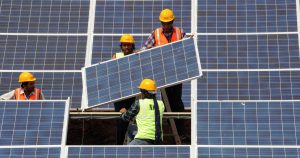India’s Renewable Energy Capacity Surges by 165% in a Decade
In a remarkable stride towards a sustainable future, India’s renewable energy capacity has soared by an impressive 165% over the past decade. This growth, which catapulted the nation’s capacity from 76.38 gigawatts (GW) in 2014 to over 203.19 GW by 2024, underscores India’s commitment to reducing its carbon footprint and transitioning to cleaner energy sources.
India’s journey in renewable energy is not just about numbers; it’s about a paradigm shift in how the country perceives and utilizes energy. As the third-largest energy consumer globally, India has been under immense pressure to meet its burgeoning energy demands while curbing emissions. This transformation is crucial not only for India but also for global efforts to combat climate change.

Solar power has been at the forefront of this renewable revolution. The installed solar capacity has increased more than 30 times since 2014, reaching 85.47 GW by mid-2024. This growth is a testament to India’s strategic investments and policy initiatives aimed at harnessing its vast solar potential, estimated at 748 GW by the National Institute of Solar Energy. The government’s push for solar parks and floating photovoltaic projects has further accelerated this expansion.
Wind energy has also seen significant advancements, with capacity rising from 21 GW in 2014 to 46.65 GW in 2024. The introduction of the Wind-Solar Hybrid Policy in 2018 has facilitated the integration of these two renewable sources, optimizing the use of land and transmission infrastructure. This policy has been instrumental in addressing the intermittency challenges associated with renewable energy, thereby enhancing grid stability.
India’s renewable energy ambitions are not limited to solar and wind. The country is also exploring other avenues such as biomass, small hydro, and waste-to-energy projects. These initiatives are part of a broader strategy to diversify the energy mix and ensure energy security while reducing dependency on fossil fuels.

The government’s commitment to renewable energy is reflected in its policies and financial incentives. Up to 100% foreign direct investment (FDI) is permitted in renewable energy projects, encouraging international collaboration and investment. Additionally, the Production Linked Incentive (PLI) scheme for solar PV manufacturing aims to bolster domestic production capabilities, thereby reducing reliance on imports.
India’s renewable energy journey is not without challenges. The country still relies heavily on coal for electricity generation, with coal accounting for over 70% of its energy mix. However, the share of coal in total power generation capacity dropped below 50% for the first time in decades in early 2024, indicating a positive trend towards cleaner energy sources.
Looking ahead, India has set ambitious targets to further expand its renewable energy capacity. By 2030, the country aims to achieve 500 GW of non-fossil fuel-based energy, a goal that aligns with its pledge to reduce carbon emissions and achieve net-zero emissions by 2070. These targets are part of India’s broader commitment under the Paris Agreement to combat climate change.
The surge in renewable energy capacity is not just about meeting targets; it’s about creating a sustainable and resilient energy future for India. The transition to renewable energy is expected to drive economic growth, create jobs, and enhance energy security. As India continues to innovate and invest in clean energy technologies, it sets an example for other nations striving to balance economic development with environmental sustainability.
In conclusion, India’s renewable energy capacity growth over the past decade is a significant milestone in the global fight against climate change. With continued investment and policy support, India is well-positioned to become a leader in renewable energy, paving the way for a greener and more sustainable future.

